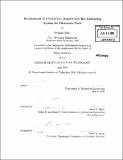Development of a low-cost, rapid-cycle hot embossing system for microscale parts
Author(s)
Hale, Melinda (Melinda Rae)
DownloadFull printable version (64.34Mb)
Other Contributors
Massachusetts Institute of Technology. Dept. of Mechanical Engineering.
Advisor
David E. Hardt.
Terms of use
Metadata
Show full item recordAbstract
Hot embossing is an effective technology for reproducing micro-scale features in polymeric materials, but large-scale adoption of this method is hindered by high capital costs and low cycle times relative to other technologies, and a general lack of manufacturing equipment. This work details a hot embossing machine design strategy motivated by maximum production speed and quality with minimal capital cost. The approach is to "right-size" the machine for specific product needs while making the design flexible and scalable. Toward this end, a minimal number of components were used, commercially available off-the-shelf components were chosen where possible, system layout was designed to be modular, and system size was scaled for the intended products (in this case microfluidic devices). Innovative design aspects include the use of new ceramic substrate heaters for electrical heating, use of a moveable heat sink to minimize heat load during the heating cycle, and the careful design of the thermal elements to minimize the heating and cooling cycle times. The capital cost and the cost per part produced with this machine are estimated to be an order of magnitude less than currently available hot embossing manufacturing options. The hot embossing machine has been tested extensively to characterize the process variability. The minimum cycle time is two minutes, and microstructures are replicated within a maximum of a 25mm by 75mm area with very low relative variance in dimensions.
Description
Thesis (S.M.)--Massachusetts Institute of Technology, Dept. of Mechanical Engineering, 2009. Includes bibliographical references (leaves 135-137).
Date issued
2009Department
Massachusetts Institute of Technology. Department of Mechanical EngineeringPublisher
Massachusetts Institute of Technology
Keywords
Mechanical Engineering.